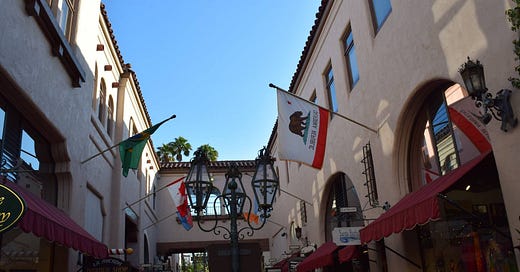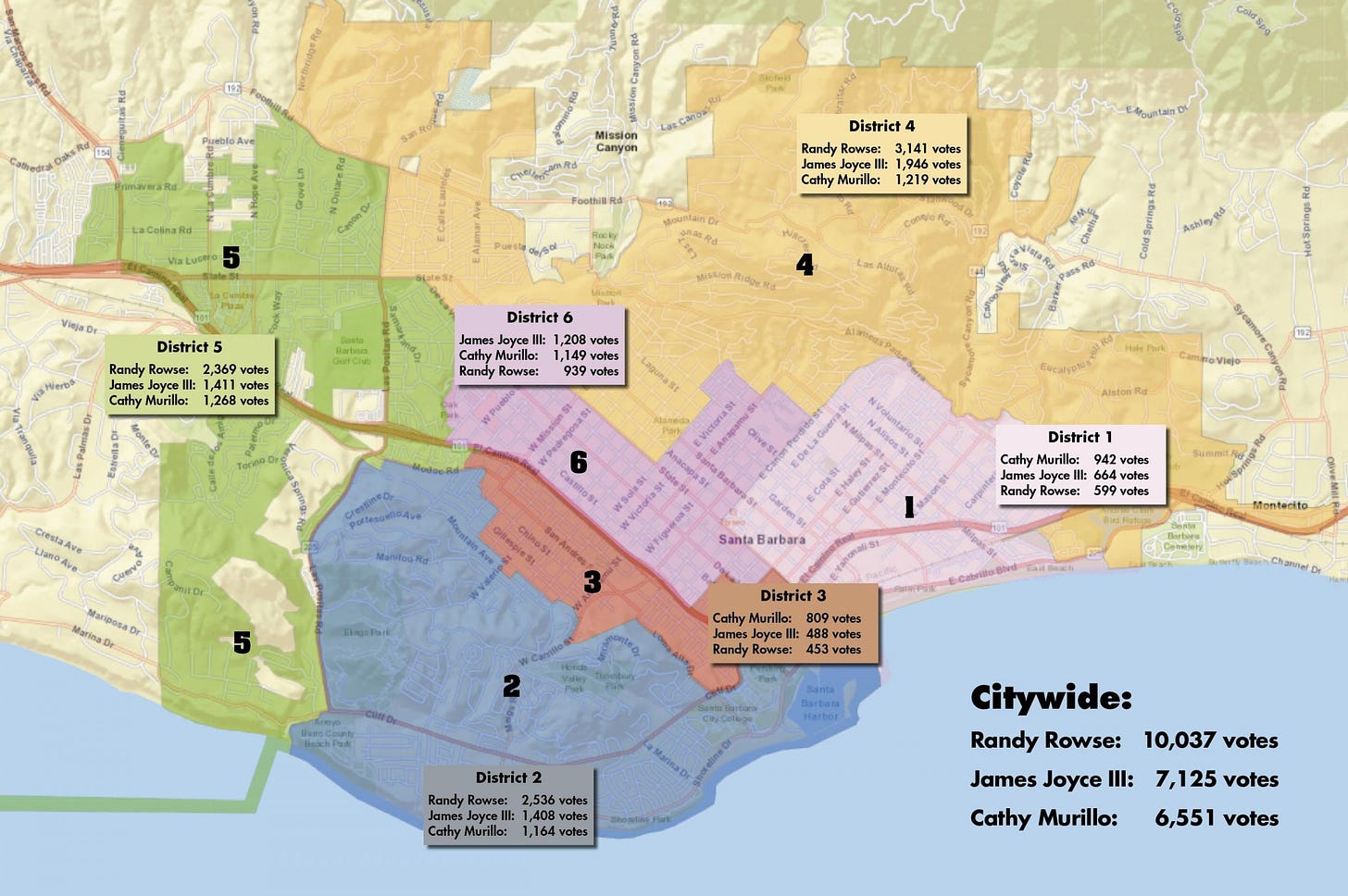NIMBY Victory in Santa Barbara’s Mayoral Race
On November 2nd Santa Barbara elected Randy Rowse, a business owner and former City Council member, as its 51st mayor. Rowse’s election was perceived as a victory for slow growth policies, even if the ousted mayor, Cathy Murillo, was far from a YIMBY. As I pointed out in my pre-election article, the longtime NIMBY stronghold of Santa Barbara is having to adapt to state imposed zoning mandates.
Of the mayoral candidates, Randy Rowse won with 38.6% or 10,037 votes, next was entrepreneur and anti-racism advocate James Joyce III with 27.41% (7,125 votes), Mayor Cathy Murillo was third with 25.2% (6,551 votes), planning commissioner Deborah Schwartz was fourth with 6.36% (1,652 votes), publisher Mark Whitehurst was fifth with 1.54% (401 votes), and Matt Kilrain was sixth with 0.2% (52 votes).
Cathy Murillo’s third place was an abysmal showing for an incumbent, as Murillo was elected in 2017 with 6,977 votes in contrast with 6,551 this election. Mayor Murillo was less popular among moderate voters and James Joyce likely split the left leaning vote with her in this non-partisan race.
Santa Barbara Mayoral Election Results by City Council District
Looking at the geographic breakdown of votes, Murillo’s stronghold of support was in the districts that make up the Eastside and Westside. This area, adjacent to Downtown, is heavily Latino, working class, has the most renters, and is the most politically left-leaning section of Santa Barbara. It was the more suburban, affluent, and moderate areas that Murillo performed the worst in, even much worse than she did in 2017. Another factor for Murillo’s abysmal showing was low voter turnout, especially among demographics that were key to her support.
Randy Rowse’s strongest performance was in the upper middle class and affluent single family home neighborhoods of the Mesa, Riviera, San Roque/Upper State Street, and the Samarkand, where the overwhelming majority of his votes came from. Support from these areas was enough for Rowse to win with a poor performance in the Downtown area, and on the Eastside and Westside. Political newcomer James Joyce usurped Murillo for 2nd spot, winning in the City Council district around Downtown. Joyce also had a strong performance in Murillo’s strongholds on the Eastside and Westside, and usurped her for 2nd place in the more affluent council districts that went for Rowse.
To give an idea of Santa Barbara’s political composition, in the last presidential primary election the neighborhoods of Downtown, the Westside and Eastside, favored Bernie Sanders, while the other more affluent suburban areas went for Joe Biden, as well as for Michael Bloomberg. Rowse, as an independent with more conservative stances, had the advantage of a split Democratic vote but also was able to appeal to many moderate Democrats. For instance Rowse had a very strong performance in the very affluent district 4, represented by Kristen Sneddon, who is perceived as far to the left of Rowse, but is also one of the most NIMBY members of the City Council. Sneddon was the only councilmember to vote against approving a new mixed-use development outside her own district on anti-gentrification grounds.
Identity politics played a major role in this election. For instance Murillo, as Santa Barbara’s first Latino mayor, had the strongest support among Latino voters. However there were criticisms that she banked too much on solidifying her base support of Latinos and partisan Democrat voters while not aggressively pursuing more moderate suburban voters.
As for the other candidates, Randy Rowse appealed the most to older and affluent voters. I would estimate that his core of support was largely from the geriatric “slow growth” demographic but also from voters who just wanted a more moderate alternative. While James Joyce split the left-leaning vote with Murillo, he also appealed to a different demographic. As the candidate most associated with the Black Lives Matter cause, Joyce appealed the most to affluent woke White voters. Think those with “We Believe” signs in front of their multi-million dollar homes. However, like Murillo, Joyce also had strong support from areas with high concentrations of renters. I’d estimate Joyce had a range of support from geriatric limousine liberals, who wanted to relive the 60s, to younger progressive Black Lives Matter supporters. He was clearly the choice among the woke vote.
The other three candidates, Deborah Schwartz, Mark Whitehurst, and Matt Kilrain, got too low of a vote count to get an assessment of their demographics of support. Unlike the “top tier” candidates, these candidates didn’t play the identity politics game to win over specific voter blocks. What these candidates did have to offer was out of the box solutions that the top candidates did not offer.
Deborah Schwartz was a pragmatic, pro-business, pro-housing, moderate Democrat with a focus on reforming city government, Matt Kilrain, “Boat Rat Matt”, was hard to pigeonhole politically with out of the box policy proposal such as granting Santa Barbara citizens a basic income by making them shareholders of the city, Santa Barbara’s own currency, and transforming big box stores into stack and pack housing for city employees, and Mark Whitehurst was notable in organizing the Downtown Art Walk. It was also notable that Schwartz and Kilrain were the most pro-new housing and in favor of zoning reform. The election results show, that despite being a Democratic stronghold, Santa Barbara is actually quite conservative in opposing any change.
Of the top three candidates, Rowse, Murillo, and Joyce, were all very skeptical of the new zoning reforms. Mayor-elect Rowse is the most aligned with the slow growth side while Murillo and Joyce opposed zoning reform on anti-gentrification grounds. In regards to zoning policy, Rowse, stated that "When you think about density and this push for density coming down from Sacramento, all these things, you go, 'Okay, let's look at the cities were density has provided affordable housing." L.A., not much. Santa Monica, not really. New York, San Francisco. The fact of the matter is, density does not affect the market, until you get to the point where it's so dense that you've diminished the quality of life. And now you've affected the market. Is that really the experiment we want to follow through? And I don't think it is."
It is hilarious that Rowse used Santa Monica as an example of a high density dystopia as it is often used as an example by LA YIMBYs as the quintessential NIMBY stronghold. It is also notable to point out that Rowse, as a business owner, flat out neglected the market fundamentals of supply and demand. Rowse also stated about the new zoning policies that “the negative effects will be felt most by low-income neighborhoods.” Rowse as the “pro-business” candidate made the exact same point about new housing causing gentrification as the more leftwing candidates, Murillo and Joyce. The framework of NIMBYism fused with anti-gentrification concerns, such as only approving low income housing, has been a consensus among Santa Barbara’s leadership. The main area where Rowse stands out, is being much more conservative on the homeless issue than the other candidates.
Regardless of who won, this mayoral election would have been a NIMBY victory, as the least NIMBY candidates performed abysmally. However this victory is only short-term due to state imposed housing mandates. The question is how the City will adapt to these mandates, as the City has established an Ordinance Committee to oversea the implementation of SB9, which will go into effect on Jan 1 2022, and allows homeowners to split their lots. The purpose of the commission is to work with the zoning loopholes that SB9 grants, such as exemptions in high-fire-risk areas, historic districts, sensitive ecological habitats such as coastal zones and creek beds, lot-split size, and protections of low income housing. Due to these loopholes it is expected that many parts of Santa Barbara will be excluded from SB9.
While these loopholes are reasonable, the City will likely use the regulatory process to stifle the implementation of SB9 with draconian affordable housing requirements that will disincentive lot splits. Design standards for lot splits, such as requiring that both the existing and new home are aesthetically compatible, are also an element of the ordinances. While these aesthetic element standards are a good compromise, they were too much for the ultra NIMBY Councilmember, Kristen Sneddon, who challenged the idea stating that “two houses with the same finishes would look worse.”
You really got to laugh at the demographic that voted against the Recall of Newsom but is now outraged by the implementation of SB9, which Newsom signed into law. This demographic still holds sway over local politics throughout the State but change is inevitable due to state mandates and a worse housing crisis. In Santa Barbara the housing crisis is putting a strain on college enrollment, service workers who make long commutes to more affordable cities, and those who grew up in the region but are priced out. Santa Barbara is a microcosm for California as a whole, in that it is one of the most desirable locales, with immense potential, but has been held back by a small minded leadership.



